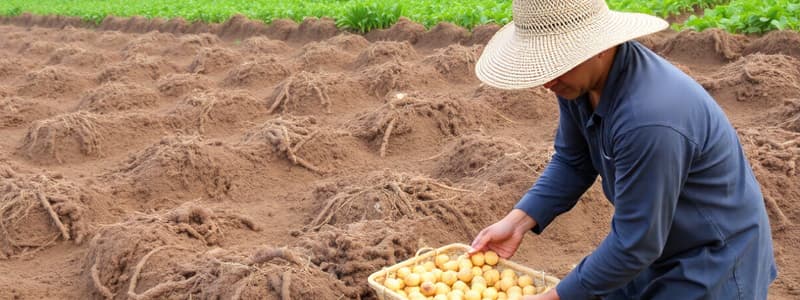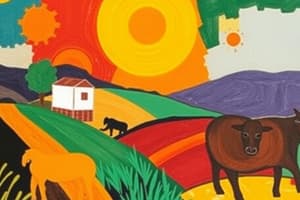Podcast
Questions and Answers
Most of our food is ______.
Most of our food is ______.
imported
A farming system consists of inputs, processes and ______.
A farming system consists of inputs, processes and ______.
outputs
Cash crops are farm produce that is sold for ______.
Cash crops are farm produce that is sold for ______.
money
Intensive farming usually involves ______ input.
Intensive farming usually involves ______ input.
Arable farming is focused on the growing of ______.
Arable farming is focused on the growing of ______.
The ideal temperature for paddy growing is between ______ and 32 degrees.
The ideal temperature for paddy growing is between ______ and 32 degrees.
The ______ region in China is known for extensive pastoral farming, producing meat and wool.
The ______ region in China is known for extensive pastoral farming, producing meat and wool.
High-technology farming relies on machines and ______.
High-technology farming relies on machines and ______.
The air temperature in the Huanan region is generally high due to more _____ and elevated temperatures.
The air temperature in the Huanan region is generally high due to more _____ and elevated temperatures.
Western China has mountainous _____, which limits flat land available for farming.
Western China has mountainous _____, which limits flat land available for farming.
Places with bad soil and short growing seasons typically practice _____ farming.
Places with bad soil and short growing seasons typically practice _____ farming.
Eastern China features _____, known for its fertile soil and increase in arable farming.
Eastern China features _____, known for its fertile soil and increase in arable farming.
The self-sufficiency rate of grains in China reaches _____%, indicating a strong local production of grains.
The self-sufficiency rate of grains in China reaches _____%, indicating a strong local production of grains.
In northern China, the long and cold _____ leads to short growing seasons.
In northern China, the long and cold _____ leads to short growing seasons.
Human activities like urban development cause a _____ of farmland, affecting food production.
Human activities like urban development cause a _____ of farmland, affecting food production.
About 20% of China’s arable land was reported to be _____ in 2014 due to pollution.
About 20% of China’s arable land was reported to be _____ in 2014 due to pollution.
Over-cultivation in areas with poor soil can lead to depletion of _____ and moisture, reducing productivity.
Over-cultivation in areas with poor soil can lead to depletion of _____ and moisture, reducing productivity.
Wind and water can easily carry away _____ when natural vegetation is removed for farming.
Wind and water can easily carry away _____ when natural vegetation is removed for farming.
Flashcards
Farming System
Farming System
A system with inputs, processes, outputs, and feedback. Inputs are what are needed, processes convert them, outputs are what's produced. Feedback is what loops back into the system.
Intensive Farming
Intensive Farming
Farming with high inputs, often on small land areas. It uses a lot of resources for high output.
Extensive Farming
Extensive Farming
Farming with low inputs, usually on large land areas. It uses fewer resources.
Arable Farming
Arable Farming
Signup and view all the flashcards
Pastoral Farming
Pastoral Farming
Signup and view all the flashcards
Cash Crops
Cash Crops
Signup and view all the flashcards
Subsistence Farming
Subsistence Farming
Signup and view all the flashcards
Climate and Relief
Climate and Relief
Signup and view all the flashcards
Growing Season
Growing Season
Signup and view all the flashcards
Self-Sufficiency Rate
Self-Sufficiency Rate
Signup and view all the flashcards
Food Demand
Food Demand
Signup and view all the flashcards
Soil Erosion
Soil Erosion
Signup and view all the flashcards
Over-Cultivation
Over-Cultivation
Signup and view all the flashcards
Productivity
Productivity
Signup and view all the flashcards
Urban Development
Urban Development
Signup and view all the flashcards
Environmental Pollution
Environmental Pollution
Signup and view all the flashcards
Study Notes
Chapter 1: Where Does Our Food Come From?
- Most food is imported, with the Mainland being a major supplier.
- A farming system involves inputs (physical and human), processes (farm activities), and outputs (crops, livestock, residues, pollutants).
- Cash crops are sold, while subsistence crops are for farmer consumption.
- Feedback within a system includes returning resources (e.g., money used to maintain inputs).
- Intensive farming uses high inputs on smaller land areas, while extensive farming uses low inputs on large areas.
- Arable farming focuses on crops, pastoral farming on livestock, and mixed farming combines both.
- Subsistence farming provides food for the farmer, while commercial farming produces surplus for trade.
- High-tech farming utilizes machinery and fuel, while low-tech farming relies more on human and animal power.
- Key vocabulary includes arable, pastoral, intensive, extensive.
Chapter 2: Where are the Farming Activities in China?
- Xibei region: Large-scale extensive pastoral farming, producing meat, milk, and wool.
- Huabei and Dongbei regions: Large-scale extensive arable and pastoral farming, with wheat, corn, potatoes, millet, soybeans, and wool as key products.
- Huanan region: Small-scale intensive arable farming, primarily producing rice, vegetables, and tropical fruits.
- Factors affecting farm type include climate (temperature and rainfall) and relief (landform).
- Ideal temperature and rainfall conditions determine suitable crops (e.g., paddy rice).
- Mountainous western regions are naturally suited for pastoral farming, while eastern plains support arable farming.
- Best farmland is often found in eastern valleys and coastal areas due to fertile soil and sufficient water.
- Key vocabulary includes annual rainfall, climate, relief, fertile, infertile, plain, growing season, temperature.
Chapter 3: Can We Produce Enough Food for Our Growing Population?
- Food supply influences economic stability; shortages can lead to economic issues and social unrest.
- Factors affecting food demand include population size and income level. Higher incomes lead to more meat consumption.
- China's grain self-sufficiency rate is high (around 95%), suggesting sufficient domestic production.
Chapter 4.1: Why Insufficient Arable Land in China?
- Physical limitations:
- Harsh climate in northern China (long winters, low rainfall) restrict growing seasons and crop yields.
- Uneven land relief (hilly, mountainous) limits available flat arable land.
- Soil erosion from steep slopes reduces soil fertility.
- Human activities:
- Urban development encroaches on farmland, especially in rapidly growing areas like the Zhujiang Delta.
- Environmental pollution (air, soil, water) damages land quality (e.g., acid rain, heavy metals, chemicals).
- Over-cultivation depletes soil nutrients and moisture. Deforestation contributes to soil erosion.
- Only about 15% of land remains suitable for farming.
- Key vocabulary includes soil erosion, productivity, over-cultivation, basin, topsoil.
Studying That Suits You
Use AI to generate personalized quizzes and flashcards to suit your learning preferences.




